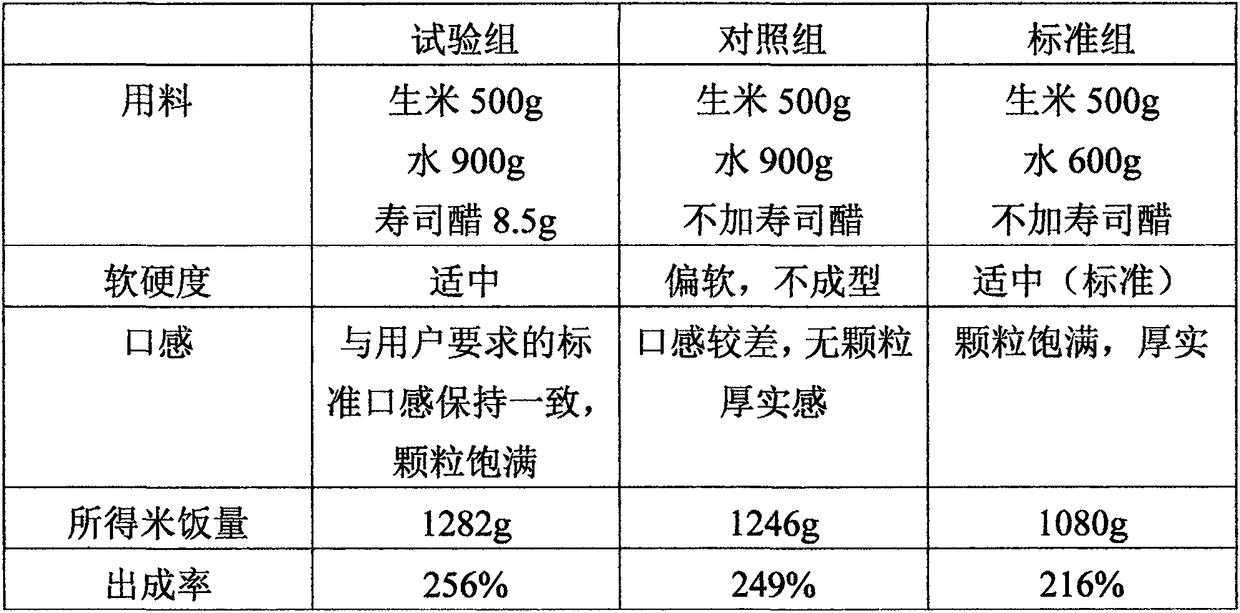Sushi vinegar
A technology for sushi vinegar and white rice vinegar, which is applied in the field of sushi vinegar, can solve the problems of long time interval from cooking to eating, difficulty in keeping rice delicious, and poor cold resistance of rice, so as to improve food safety, maintain glossy appearance for a long time, and improve The effect of steam yield
- Summary
- Abstract
- Description
- Claims
- Application Information
AI Technical Summary
Problems solved by technology
Method used
Image
Examples
preparation example Construction
[0019] The preparation method of the sushi vinegar is as follows: firstly, each raw material is weighed according to the proportion, and then mixed and stirred until there is no residual solid component in the solution.
[0020] Sushi vinegar is added during the process of turning raw rice into cooked rice.
[0021] The method of using sushi vinegar is: add water and sushi vinegar to raw rice, stir and mix, and then heat to get cooked rice; finally observe the state of rice, the degree of water addition, etc., and then adjust.
[0022] Sushi vinegar is added in an amount of 1.5-2% of raw rice in terms of mass percentage. Preferably, the added amount of sushi vinegar is 1.7% of the uncooked rice in terms of mass percentage.
[0023] The water consumption of sushi vinegar added together with it increases by 40% to 60% compared with the water consumption without sushi vinegar.
Embodiment 1
[0026] Prepare 1000g of sushi vinegar.
[0027] First weigh the following raw materials:
[0028] White rice vinegar 320g, sorbitol 260g, sodium citrate 120g, trehalose 135g, edible salt 145g, water 120g.
[0029] The above raw materials are put into a container, fully mixed and stirred until there is no residual solid component in the solution, and the sushi vinegar is obtained.
Embodiment 2
[0031] Get the sushi vinegar that embodiment 1 prepares and test.
[0032] The sushi vinegar is added in the process of heating raw rice into cooked rice. The amount of sushi vinegar added is 1.7% of the weight of raw rice, and an additional 300g of water is added per 500g of rice on the basis of the normal amount of water added.
[0033] The specific test groups are as follows.
[0034] Test group: 500g of raw rice, 900g of water, and 8.5g of sushi vinegar.
[0035] Control group: raw rice 500g, water 900g.
[0036] Standard group: 500g raw rice, 600g water.
[0037] Three sets of experiments were used to judge the yield rate after using sushi vinegar while maintaining the best taste. In order to improve the accuracy, each group was tested twice, and the average value of the two tests was taken.
[0038] In order to improve the accuracy, the commonly used Northeast rice was used in this experiment, and it was steamed for 45 minutes with the same procedure.
[0039] The ...
PUM
 Login to View More
Login to View More Abstract
Description
Claims
Application Information
 Login to View More
Login to View More - R&D
- Intellectual Property
- Life Sciences
- Materials
- Tech Scout
- Unparalleled Data Quality
- Higher Quality Content
- 60% Fewer Hallucinations
Browse by: Latest US Patents, China's latest patents, Technical Efficacy Thesaurus, Application Domain, Technology Topic, Popular Technical Reports.
© 2025 PatSnap. All rights reserved.Legal|Privacy policy|Modern Slavery Act Transparency Statement|Sitemap|About US| Contact US: help@patsnap.com

